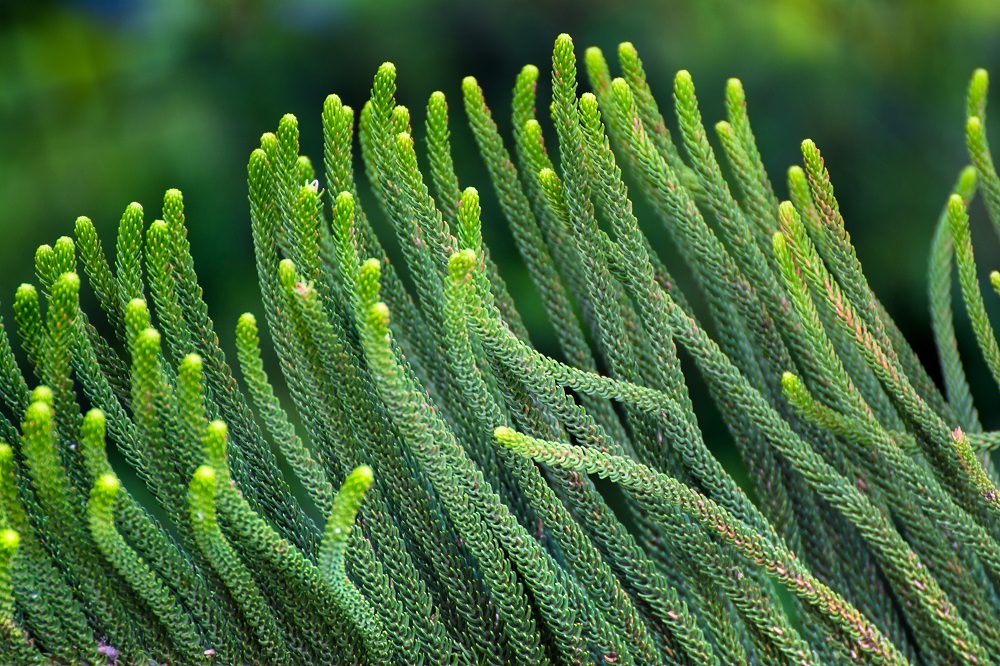Cryptomeria
Common Name:
Japanese cedar

General information:
The tree keeps a billowy pyramidal form on one central trunk until close to maturity when the crown opens up into an irregular, narrow oval. It will reach a height of about 50 feet and spread about 20 feet. Old specimens can develop trunks to three feet in diameter. The reddish brown bark is ornamental, peeling off in long strips, and is the most pronounced characteristic on old trees. The foliage will become bronzed during the winter but greens up again in spring. Branches usually persist on the tree with old specimens branched to the ground.
Cryptomeria is much loved in Japan as an ornamental and as a bonsai. Although it is called the Japanese cedar, it is not a true cedar (Cedrus). It has compact blue-green foliage and peeling red bark. It has small needles 3/4 inch or smaller. Cryptomeria japonica is the only species of this genus, but there are many cultivars available.
Family:
Taxodiaceae
Lighting:
Full sun.
Temperature:
Hardy in zones 6-8. If the Cryptomeria is kept outside during winter, it is likely that the foliage will turn reddish-brown in reaction to the cold. This is natural, and even though the plant looks somewhat like it is dying, it should recover in the spring if it is not exposed to temperatures below its tolerance. Always shield from strong winds.
Watering:
Moderate, but never allow the soil to dry out. Cryptomeria can be quite thirsty in summer and needs constant checking. Likes misting, and tends to lose needles if there is not enough humidity.
Feeding:
Spring-autumn, every 14-30 days.
Pruning and wiring:
The compact habit of the Cryptomeria necessitates vigilant pruning of new growth, entangled branches and overlapping shoots. This will provide space for light and air to reach the desired foliage, and reduces the likelihood of fungus and insect problems. Pinch back new growth, as clipping with scissors results in browning tips. The plant tends to thicken at intersections between trunk and branches, so unwanted upper branches should be removed promptly to avoid loss of trunk taper. Unwanted branches are often turned into jins. The Cryptomeria is most often styled as a formal upright, or as part of a forest planting. It is also often used in sakei. Cryptomeria should be pruned and wired from mid-spring through the end of summer. Do not work on Cryptomeria during winter. The Cryptomeria is delicate after pruning and wiring, and should be pampered by shielding it from sun and wind and misting several times a day for a few weeks after it has been worked upon.
Propagation:
By simple layering, or softwood cuttings in summer. Cryptomeria can be grafted, but this is generally done only by professionals. Cryptomeria seeds do not germinate reliably.
Repotting:
Every 3-5 years in spring, after growth has begun. Root pruning should be very gradual, and occur a year after selective reduction of the foliage.
Pests and diseases:
Pests:
Mites and scale can infest the foliage.
Diseases:
Leaf blight and leaf spot are two problems. Leaf blight often causes much of the interior foliage to brown, creating an unsightly specimen. Fungicide sprays help prevent the disease, as does placing the tree so it receives early morning sun to dry the foliage. Keep the foliage as dry as possible.
Some species suitable for bonsai:
Cryptomeria japonica ‘Bandai-sugi’: conical cryptomeria - a dwarf cv which grows to about 6 feet tall.
Cryptomeria japonica :Jundai-sugi’: globular cryptomeria Cryptomeria japonica ‘Lobbi Nana’: dwarf cryptomeria
Cryptomeria japonica ‘Pygmaea’: dwarf cryptomeria
Cryptomeria japonica ‘Tansu’: Japanese cedar, Tansu cryptomeria Cryptomeria japonica ‘Tokyo’
Cryptomeria japonica ‘Viminalis’
Cryptomeria japonica ‘Yatsubusa’: Japanese red cedar - a dwarf form with a naturally narrow conical form and compact foliage.
Cryptomeria japonica ‘Zuisho’
Bibliography:
USDA Fact Sheet ST-217
Compiled by Sabrina Caine Edited by Thomas L. Zane
